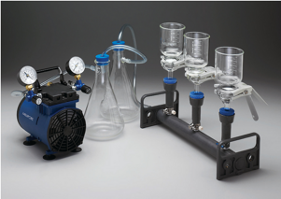How to dry the resulting fractions obtained from a preparative fractionation system
- September, 22 2020
- Category: Preparative Fractionation, Filtration

Preparative fractionation systems, like PREP mc2 and PREP C20, fractionate polymers by dissolving them in the appropriate solvent and then separating their molecules according to certain parameters, such as molecular weight and crystallinity.
At the end of the process in the preparative system, the resulting polymer fractions are still mixed with the solvent, so we need to remove the solvent in order to obtain the dry polymer for each fraction.
In this article, we will explain the steps and equipment needed to dry these fractions.
Step 1: Pre-treatment
To improve the precipitation of the polymer fractions, we add a very polar solvent with a low boiling point (like acetone or methanol) to the solution, in a 1:1 ratio of polar solvent to fractionation solvent, and we place this mixture in a refrigerator for 2 – 4 hours (depending on the fractionation solvent’s freezing point. We normally use o-DCB).
To reduce the amount of polar solvent needed, some of the solvent from the collected solution can be evaporated first by using a rotary evaporator.
Step 2: Filtration
For this step we use a filtration system connected to a vacuum pump.
This vacuum filtration system consists of a vessel with a glass filter, an Erlenmeyer flask to collect the solvent, and a vacuum pump to draw the solvent from the vessel into the flask through the filter. A PVDF membrane of 0.45-micron pore size is used to retain the polymer for each fraction.
Different configurations are available, for instance, the filter discs can be of 47 or 90 mm in diameter, and the system can also have 3 or 6 vessels with filters.

Filtration system with 3 vessels and 47 mm filter disks.
Using one of these filtration systems, we pour the polymer solution into the vessels and turn the pump on to start the filtration. Once the vessel is empty of solvent, and the polymer is left on the PVDF membrane, we pour around 100ml of acetone (or any polar solvent) into the vessel. This is very important, as washing the polymer with acetone will remove any solvent traces that could later interfere in the results when analyzing the fractions.
Step 3: Drying
Once washed, the polymer fractions can be removed from the PVDF membrane and placed in a petri dish to let the acetone evaporate.
To make sure that no solvent is left on the polymer fractions, we put the fractions in a vacuum oven and let them dry overnight. This step is not completely necessary if the fractions have been washed very carefully.